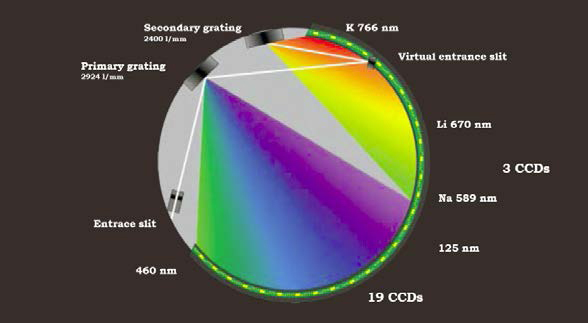SPECTRO Ciros SOP ICP-optical emission spectrometer (ICP-OES)
Instrument
Simultaneous CCD ICP-optical emission spectrometer in Paschen-Runge configuration.
Technical Data/Features
In contrast to mass spectrometers, inductively coupled plasma optical emission spectrometry (ICP-OES) uses electromagnetic radiation (light) emitted from excited atoms, molecules, and their ionised forms for identification and quantification of elements contained in a sample. A sample liquid is nebulized and subsequently desolvated in the inductively coupled argon plasma (ICP) at temperatures of ?6000K. Atoms, molecules and ions in the plasma Ãvapourà are excited into a state of radiated light (photon) emission. This emitted light is passed to the spectrometer optical system where it is diffracted by two optical gratings and focused onto a continuous circular array of detectors (Paschen-Runge). In total 19+3 charge coupled device chips (CCD) are arranged on the Rowland circle covering a wavelength range from 125-770 nm. The radiation intensity of a specific wavelength is proportional to the concentration of the element in the sample. Element concentrations can be calculated by instrument software from a stored set of calibration functions. Spectral interferences must be recognized and considered. Internal standardization can be applied for correction of transport interferences. Typical detection limits are in the low ?g/L range being several magnitudes above what is achievable with ICP-MS methods. This makes ICP-OES a complimentary technique for the determination of major and minor elements. Analytical error for concentration data is typically less than 1-2 percent rel. but much better than 0.08 percent rel. for elemental ratios.
Application
Routine applications in our lab are the determination of major and minor element composition of seawater, porewater, hydrothermal fluids, of rocks and minerals as well as synthetic high-tech materials.
The truly simultaneous signal processing with the continuous CCD detector array accomplishes the acquisition of very high precision data for elemental ratios that is of the same quality as, or even better than, data obtainable with multi-collector MS. This advantage is utilised for the precise determination of e.g., Mg/Ca and Sr/Ca elemental ratios as proxies in corals, foraminifera, shells, red algae for the reconstruction of e.g., paleo-seawater temperatures.
Keywords
Optical Spectrometry, Element Analysis, Materials Analysis

